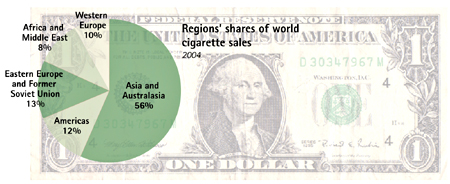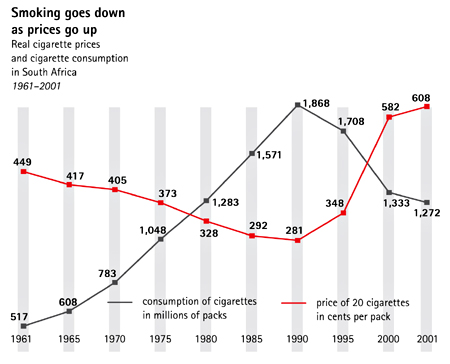Center for Communications, Health and the Environment

Q&A With Dr. Judith Mackay
 Dr. Judith Mackay, Director, Asian Consultancy on Tobacco Control, Kowloon, Hong Kong, and Director of Global Tobacco Control Programmes, and Project Coordinator, Bloomberg Initiative to Reduce Tobacco Use, World Lung Foundation
Dr. Judith Mackay, Director, Asian Consultancy on Tobacco Control, Kowloon, Hong Kong, and Director of Global Tobacco Control Programmes, and Project Coordinator, Bloomberg Initiative to Reduce Tobacco Use, World Lung Foundation
1. What progress has been made in tobacco control since the 2002 Tobacco Atlas was published?
An astonishing amount of progress has been made, but first the bad news:
- The number of smokers is rising, mainly due to population expansion in developing countries.
- The number of tobacco deaths is increasing.
- Global tobacco consumption is rising.
Thus, the epidemic is not being reduced; it is expanding, and is being transferred from the rich to the poor countries, which can least afford the economic burden.

The good news is that:
- Systems are being put in place that will eventually reduce this epidemic. Of this I am certain, but it will take a long time.
- The WHO Framework Convention on Tobacco Control (FCTC), the world's first public health treaty, is one of the fastest-track UN treaties of all time. It currently has 168 signatories, and more than 150 states are parties to it.
- Donors to tobacco control are increasing. For example, with an initial two-year donation of US$125 million, the Bloomberg Initiative to Reduce Tobacco Use represents the largest-ever effort to fight tobacco in low- and middle-income countries . The initiative, which employs about 120 people, supports resource offices, a grants programme, training in tobacco control as well as in finance and budgeting, prevalence and tobacco-control surveys, and advocacy.
- The prevalence rates of male smoking are falling in most places in the world, and the predicted rise of smoking among women in developing countries has not occurred.
- Many nations have implemented strong tobacco-control measures.
Several international, regional and national tobacco-control meetings have taken place; and journals such as Tobacco Control continue to expand, while articles on tobacco are appearing in other publications.
2. What tobacco-control measures are the most responsible for these improvements, and what measures have failed and why?
Increased taxation is THE single most effective way of reducing smoking, especially amongst the young. Bans on all tobacco advertising and all other promotion, plus the creation of smoke-free public and workplaces, are also critically important.

Measures that are least effective (and the only ones fully supported by the tobacco industry) include bans on sales to minors, traditional schools programmes and weak health warnings. Schools programmes fail because they are poorly funded (in contrast to industry promotion budgets) and because they typically focus on the health consequences of tobacco use decades ahead, an approach that does not resonate with young people. As Yussuf Saloojee of South Africa recently remarked, “The irony is that the tobacco industry uses images of health to sell death, while health organizations use images of death to sell health."
3. What governments and anti-tobacco groups are currently doing the most to combat the tobacco epidemic, and what noteworthy actions are they taking?
Many developing countries have taken action ahead of developed nations, showing that tobacco control is not only a prerogative of developed countries, but also a viable option in poor countries. Examples of measures adopted in less-affluent countries range from banning all sales and duty-free cigarettes to using 4 percent of tobacco taxes to fund tobacco-control activities. Many tobacco-control measures, like packet warnings or the creation of smoke-free areas, cost little or nothing, while other measures, such as tax increases, actually generate income.
4. Where have governments and anti-tobacco activists failed and why?
Governments have failed where they have not grasped the political nettle of tobacco control and, instead of resolute tax increases and legislation, have tried to introduce measures favoured by the tobacco industry, including voluntary agreements instead of laws, and partial bans on promotion rather than comprehensive bans.
In my opinion, tobacco-control activists have often succeeded against all odds, and “failed” only in that they have not always been able to make more headway – and that's simply because, up until now, they have had virtually no funds and little global support for a career path in tobacco control. Thankfully, this is beginning to change.
5. What do you think about the FCTC and its global impact? How can WHO get more countries to ratify it and implement its strategies and restrictions?
The FCTC is not our only tactic, but it is an incredibly important component in global tobacco control, if not the central component. It places governments under international obligation to introduce tobacco-control measures. It has rallied governments and NGOs. It has “kicked tobacco upstairs,” because signing a UN treaty is a whole-government position, rather than just an individual Ministry of Health one, which means that all ministries are involved. The FCTC is also providing funding for tobacco control and attracting donors like the Bloomberg Initiative.
With regards to ratification and implementation, some of the FCTC articles carry a time commitment; others do not. But substantial progress has already been made at the Conference of Parties (COP) in developing protocols and guidelines.
The greatest fear I have encountered with countries is that the FCTC will harm the economy and put farmers and other workers out of a job. There needs to be a huge amount of reassurance on the economic equations to countries that this is not so. In fact, health economists are unanimous in concluding that tobacco control is good for the wealth, as well as the health, of nations.
6. What is the single most important change that needs to take place to reduce global interest in and dependence on tobacco?
That's easy: government commitment. National governments need to step up, and take a stand to end the economic and emotional stranglehold that the tobacco industry has on just about every single country around the world.
7. What can nonsmokers do to protect themselves and curtail the epidemic?
They can support smoke-free areas, whether this be by lobbying for changes in the law, or by establishing personal smoke-free homes to protect children.
8. As the group most negatively affected by tobacco and smoking, how can teens, and even younger children, make a difference and take the lead in targeting tobacco?
Children can individually ask parents, and other adults, not to smoke around them; but this can be difficult and the effects minimal, as children and young people traditionally have no or little voice in families and society, or with governments. That said, youth organizations can, and should, join the campaigns for smoke-free areas, especially targeting those places that cater to children, such as schools, playgrounds and homes.
9. To what extent is tobacco use, particularly smoking, contributing to global pollution and the consequences of global warming?
I don't think we have worked out an exact figure for this, but tobacco use certainly affects the environment in many ways, including: tons of daily waste from packaging, matches, lighters and discarded cigarette butts; deforestation due to the cutting down of trees to cure tobacco; fires caused by careless smoking within the home and the countryside; damage to buildings; and pesticide and fertilizer pollution from the growing and harvesting of tobacco.
10. China's a “smoking gun,” so to speak. Where are the next tobacco hotspots, and how can we intervene now to change their course?
The five countries with the largest number of smokers are China, India, Indonesia, Russia and Bangladesh, so reducing smoking prevalence in these nations would have the biggest impact on improving health. Meanwhile, the tobacco industry has targeted developing countries and the newly industrialized nations of Central and Eastern Europe as their main growth targets, so intervention in these areas would also be prudent.
Interventions require sustained government and NGO commitment to tobacco control, especially through the FCTC. But almost everyone has a role – including civil society, parents, teachers and the media.
11. Women are increasingly interested in lighting up, especially in developing countries. Why is this, and what measures can women's movements take at the local, national and global levels to curtail the impact of tobacco promotion directed at them?
The predictions of a significant rise in smoking among women in developing countries has not materialized, even with greater social, family and financial independence of women. This should definitely NOT lead to complacency, but be viewed as the biggest opportunity in primary prevention in the world. Also, the results of WHO's Global Youth Tobacco Survey (GYTS) show that girls are smoking almost as much as boys in many places, so vigilance and action must be maintained. In addition, deglamourizing tobacco by banning all promotion, and the “hidden” advertisements of smoking in movies and TV, would help the cause.
12. If you had one wish related to tobacco or smoking, what would it be? Who or what would most likely ensure that this wish was granted?
My wish is that:
- Globally, all nations ratify the FCTC.
- Nationally, the tobacco industry comes under long-overdue and appropriate regulation. We currently regulate all manner of much safer products more than we do tobacco, from food and consumer goods to pharmaceutical products and alcohol.
Only governments can grant these wishes – and curtail the tobacco epidemic.
Click here to read: Lead Article | Q&A | CECHE News

Dr. Sushma Palmer, Program Director
Valeska Stupak, Editorial & Design Consultant
Shiraz Mahyera, Systems Manager
Rohit Tote, Website Consultant